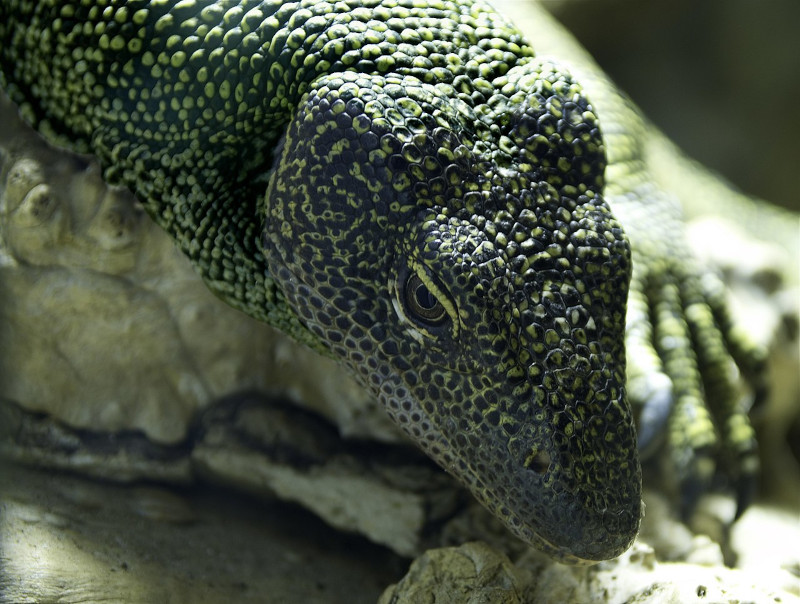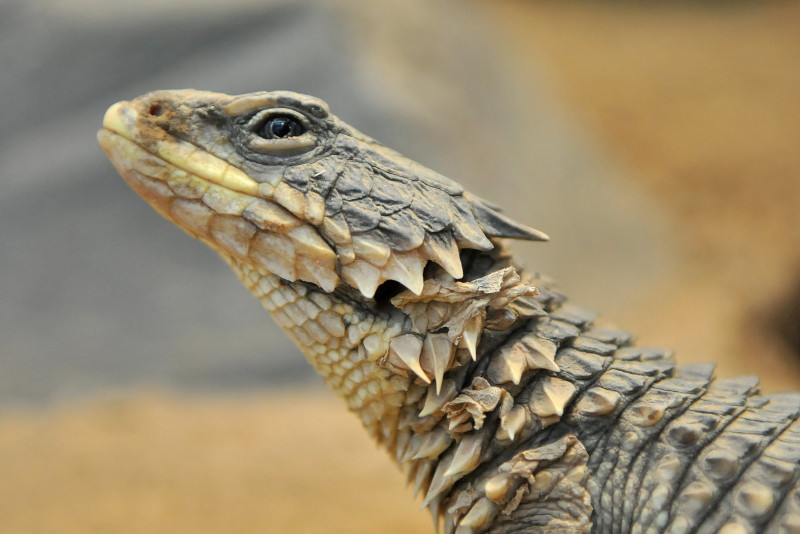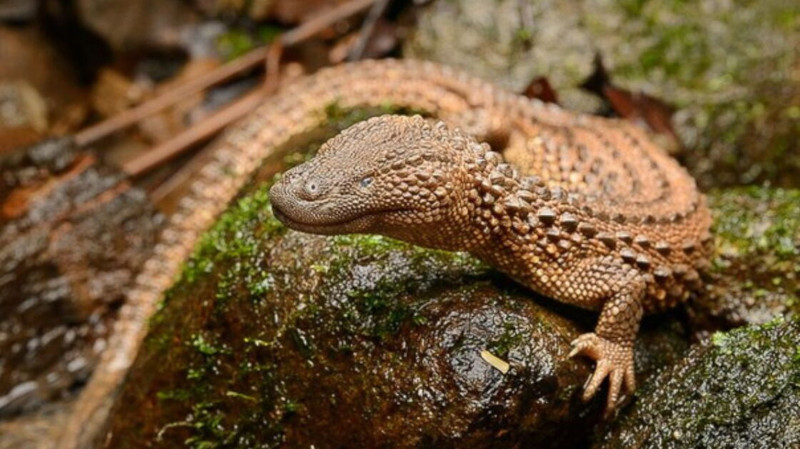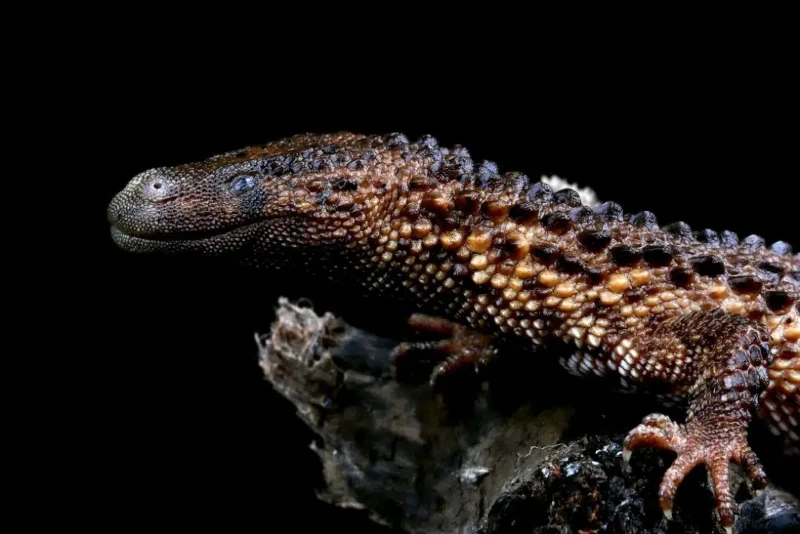Earless Monitor Lizard Facts
- This extraordinary reptile most frequently goes by the highly descriptive common name of the Earless Monitor Lizard across its range. The creature does have several other general titles it’s known by, though. These include the Borneo Dragon and Lesser Earless Monitor Lizard.
- Within scientific circles, however, it’s possibly significantly better known by its technical designation. Sadly, though, that term’s extremely difficult for the layperson to pronounce easily. That’s because the animal holds the tongue-twisting formal tag Lanthanotus borneensis.
- The amazing animal received that difficult moniker due to the efforts of Franz Steindachner. The respected Austrian herpetologist recorded the first recognition of it as a separate and distinct species. He achieved that scientifically noteworthy accomplishment in the year 1878.
- The marvel of Nature and evolution remains notable to the world of science for several reasons. Most importantly in this regard, the reptile represents the only known surviving species in the Family Lanthanotidae. It’s also related to the true monitor lizards of the world.
- Regrettably, the remarkable Earless Monitor Lizard finds itself in a precarious position for several reasons. The very nature of its habitat range ranks high among these factors. Due to its situation, the IUCN currently shows it as Endangered on its Red List of Threatened Species.
- The intriguing product of Nature also currently faces other threats to its continued existence, of course. Like all other forms of life on earth today, most of those dangers stem from the actions of mankind. High on any such list stands the threat posed by ongoing climate change.
Related Articles



Earless Monitor Lizard Physical Description
The incredible Earless Monitor Lizard generally captures the attention of those individuals fortunate enough to encounter one of these marvels. The animal typically does so, however, due to its distinctive appearance, not its size. That’s because it’s not an overly large species of reptile.
Regarding its physical appearance, though, the interesting lizard tends to follow a general pattern of physical development common to many creatures. That’s evidenced by the fact that this marvel of Nature displays a certain degree of the physiological characteristic of sexual dimorphism.
This natural trait actually manifests itself in several ways, however. As a general principle, females typically attain slightly greater body lengths than their male counterparts. The difference remains minor, though. Overall, the species averages roughly 8 – 10 in (20 – 25 cm), including the tail.
Females also often exhibit a slightly more rounded body shape than the males, especially during the breeding season when they’re carrying eggs. This occurs due to the development of eggs within the reproductive tract, which understandably leads to a noticeable increase in terms of girth.
Meanwhile, males of this amazing reptile typically distinguish themselves by having slightly broader and more robust heads compared to the females of the species. This feature’s possibly associated with differences in its behavior or diet, as sometimes occurs among other lizard species.
Otherwise, the two genders present the same basic outward appearance to the observer. Except for any gravid females, it possesses a comparatively slender, elongated body covered with small, smooth scales. The coloration generally presents as either a light to dark brown or dark gray
The tail develops as slightly shorter than the body, yet extremely muscular and robust. It’ also likely used for balance and swimming. This appendage further tapers to a very fine point. Like many lizards, the unjique animal also has a forked tongue, which it uses to sense its surroundings.
This astounding reptile holds yet still more points of interest for the viewer. It additionally evolved short, sturdy limbs, relative to its body size. Each of these appendages comes equipped with well-developed claws, which help it in digging and navigating through its native environment.
Yet, it’s the head of the remarkable Earless Monitor Lizard that usually receives the most attention. This body part remains somewhat flattened, and boasts a clearly pointed snout. Unlike many other lizards, this particular species developed very small eyes, situated on the sides of the skull.
Despite its partially deceptive common name, the intriguing creature actually does have ear openings. These do, however, remain extremely small and not usually externally visible. This occurs due to a combination of their small size and the rough quality of the texture of their skin.
- Kingdom: Animalia
- Phylum: Chordata
- Class: Reptilia
- Order: Squamata
- Family: Lanthanotidae
- Genus: Lanthanotus
- Species: L. borneensis
Earless Monitor Lizard Distribution, Habitat, and Ecology
Unfortunately, the remarkable Earless Monitor Lizard evolved as indigenous to a relatively small portion of the surface of the earth. Precisely where that zone of habitation lies might surprise some of our readers, though. It’s only native to a very specific section of southeastern Asia.
In fact, the wonder’s only known to dwell on the island of Borneo. But even there it’s known presence remains limited to a few highly select areas. It’s found primarily in the regions of Sarawak and Sabah in the section claimed by Malaysia, as well as the part claimed by Indonesia, Kalimantan.
This fascinating lizard also displays decidedly strong, clear, and extremely specific preferences regarding its choice of habitat. These, in fact, remain crucial for its survival, given its limited territory and population numbers. Due to its range, however, its typical nature isn’t at all surprising.
This wonder of the reptilian world frequently makes its home in regions comprised of lowland tropical rainforests. These settings serve to provide it a humid and stable climate essential for its well-being. The dense forest cover also offers protection and an abundance of food sources.
The fascinating creature’s also often associated with areas near freshwater sources, such as various streams, rivers, and swamps. These various bodies remain crucial for its habitat, providing hydration, and contributing to a moist environment that suits its typically semi-aquatic lifestyle.
It’s often found in leaf litter or under decaying wood and logs, which provide it with both shelter and hunting grounds. The lizard also prefers warm, humid conditions typical of its chosen habitat. These support its many physiological needs, particularly its skin and respiratory systems.
This wonder of Nature and evolution fills a very unique evolutionary niche within its ecosystem. It evolved a carnivorous diet, primarily feeding on small invertebrates, such as insects, worms, and others. Its feeding habits possibly also include small vertebrates such as small fish and amphibians.
It’s generally nocturnal in its activity patterns, hunting either during the night or twilight hours when it can more easily avoid predators and competition. The animal’s also semi-aquatic, often being found near small, calm bodies of water. It’s a good swimmer as well, often foraging in water.
Meanwhile, the reproductive behavior of the Earless Monitor Lizard isn’t very well-documented, since it’s highly reclusive. But, like many reptiles, the majority of researchers believe it to lay eggs. The number of eggs and specific nesting behaviors continue to still be subjects of ongoing studies.
Likewise, specific knowledge regarding its own predators remains scant. Based on its size and habitat, potential predators likely include several possibilities, though. It most likely represents a prey species to birds of prey, larger mammals, various snakes, and even other, larger lizards.
Species Sharing Its Range



Check out our other articles on 3 Beautiful Canadian Butterflies, Striped Dolphin, Tenerife, Bird’s Foot Violet, Old World Swallowtail, Southern Darwin’s Frog, Texas Alligator Lizard











Leave a Reply